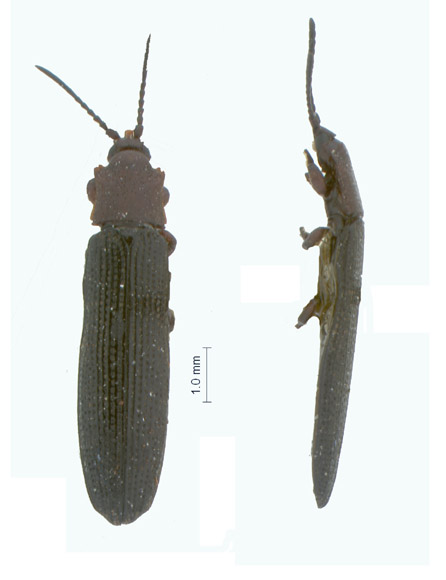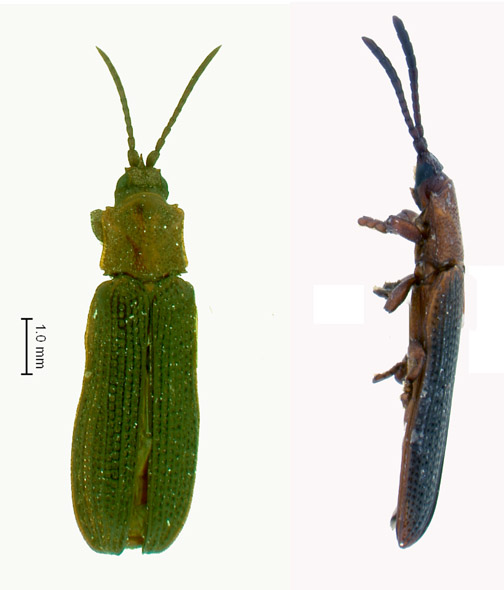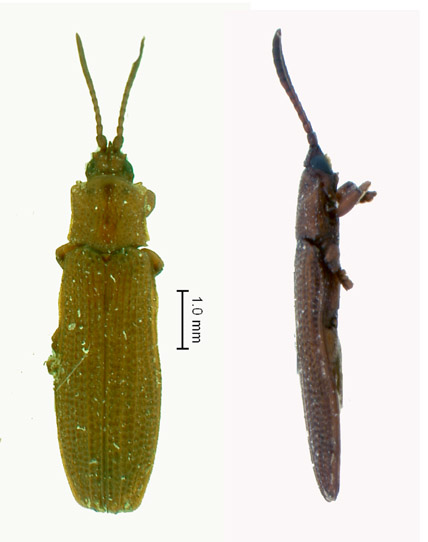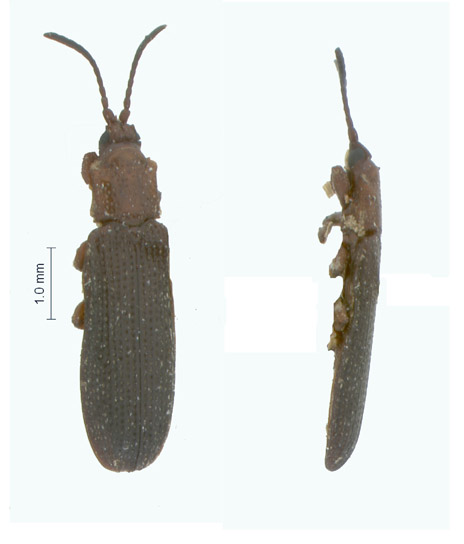Octodonta
Introduction
Octodonta Chapuis (Coleoptera: Chrysomelidae: Cassidinae) contains nine species from the Pacific Region and is in need of revision (Staines 2012). Six species have been associated with palms. Octodonta nipae (Maulik) is the best studied species and has been introduced into China (Sun et al. 2003) and Cyprus (Vassiliou et al. 2010) via nursery plants. Life history observations have been made by Corbett (1929), Hou & Weng (2009), Kalshoven (1981), Maulik (1921), Sivapragasam & Hong (2007), and Susainathan (1924) and are summarized in the Damage and Life History Notes below.
Distribution
Octodonta affinis (Uhmann) is found in Indonesia (Java).
Octodonta angulosa (Uhmann) is found in Philippines (Luzon, Mindanao, Mindoro).
Octodonta banguiensis (Uhmann) is found in Philippines (Luzon).
Octodonta depressa Chapuis is found in Indonesia (Java, Sumatra), Malaysia, Philippines (Mindanao), Taiwan, Thailand, and Vietnam.
Octodonta nipae (Maulik) is found in China (Hainan) and Malaysia.
Octodonta surigaoana (Uhmann) is found in Philippines (Mindanao).
Hosts
Octodonta affinis feeds on Cocos nucifera L. (Lepesme 1947) and Metroxylon sp. (Kalshoven 1951) (Arecaceae).
Octodonta angulosa feeds on Cocos nucifera L. (Arecaceae) (Lepesme 1947).
Octodonta banguiensis feeds on Cocos nucifera L. (Arecaceae) (Maulik 1937).
Octodonta depressa feeds on Normanbya merrillii Becc. (Gestro 1919); Cocos nucifera L. (Lepesme 1947); and Calamus sp. (Zaitsev 2006) (Arecaceae).
Octodonta nipae feeds on Nipa fructicans Thunb., Metroxylon sagu Rottb., Oncosperma sp. (Maulik 1921); Areca catechu L. (Lepesme 1947); Calamus manan (Steiner 2001); Washingtonia filifera (Linden ex. André) H. Wendl. (Sun et al. 2003); Phoenix canariensis Hort. ex Chabaud, P. hanceana Naud, Archontophoenix alexandrae (F. Müll.) H. Wende & Drude, Dypsis lutescens (H. Wendl.) Beentje & J. Dransf., Cocos nucifera L., Elaeis guineensis Jacq., Hyophorbe lagenicaulis (L.H. Bailey) H.E. Moore, Livistona chinensis R. Br., Roystonea regia H.B.K., Washingtonia robusta H. Wendl. (Hou & Weng 2009); and Syagrus romanzoffiana (Cham.) Glassman (Vassiliou et al. 2010) (Arecaceae).
Octodonta surigaoana feeds on Cocos nucifera L. (Arecaceae) (Lepesme 1947).
Damage
Octodonta nipae causes damage similar to that of Brontispa longissima (Gestro) and Plesispa reichei Chapuis on sago palm in Malaysia. In some cases it can cause defoliation. Larvae and adults attack unopened fronds of hosts above three years of age. In heavy infestations, leaflets of younger (central) fronds appear withered, grey-brown and with rolled edges. This insect can cause significant damage to all its hosts, and high infestation levels may result in tree death. Damage to the epidermis and parenchyma by feeding adults and larvae affect the ability of the leaf to photosynthesize producing brown patches and die back. Complete defoliation can occur in severe infestations. The ability of the palm to produce reproductive structures and fruit is severely compromised and the palms also become susceptible to drought and diseases such as fungal rot (see fact sheets Gliocladiom Blight and Gliocladium Trunk Rot, Leaf Spots and Leaf Blights, Pestalotiopsis Rachis Blight and Crown Rot for examples). In older palms the fronds become yellowed and ragged and the general appearance of the tree, if it survives attack, is unsightly.
The necrotic areas eventually shatter, leaving only the midveins intact. The adult beetles feed on the lower surfaces of leaflets. Adults and larvae feed on the parenchyma of both surfaces of the closely oppressed leaflets. By feeding, they remove strips of tissue from both sides of the leaves, resulting small brown patches of varying sizes and light brown streaks as the frond opens. The brown patches shrivel and curl giving the leaf a typically, scorched, ragged appearance. The adults leave narrow linear chewing marks and cause less damage than the larvae. Later, these feeding lines mingle with each other so that the remaining tissues dry up and rot. Infestations result in the reduction of the amount of reserves available to the plant to produce new growth or form reproductive structures. Larvae chew large areas of the leaflets killing underlying tissues and reducing leaf photosynthesis, which may be reduced to zero. Palms may be killed as a result of sustained attack by these beetles.
Life history notes
By day larvae and adults of O. nipae can be found together in the tightly furled fronds and trunk fibers. Adults disperse by flight. Mating and external activity of adults takes place at night. This species is gregarious and many adults and larvae may be found on one palm. Females lay eggs in clusters at the ends of adult feeding scars and cover them with regurgitated leaf fiber. The incubation period of the eggs is about a month. Up to five larvae may occupy one mine. The larval period is about five weeks, during which the larvae grow to a length of about 1 cm. The pre-pupae locate themselves in the middle of the mine. The pupal stage lasts about 2-3 weeks. The life cycle from egg to adult may take from five to nine weeks depending on temperature (Hou & Weng 2010). Adults may live around 150 days. Females lay on average 120 eggs but Fengyu et al. (1009) have found that fecundity and longevity are affected by the species of palm the beetle feeds on. According to preliminary investigations, insect generations overlap, flying ability is somewhat weaker than the coconut leaf beetle (Brontispa longissima).
The development duration and survival of O. nipae on different host plants was studied in the laboratory by Fengyu et al. (2009). Life span of O. nipae on S. romanzoffiana (Cham.) Glassman, Washingtonia robusta H. Wendl., and Phoenix dactylifera L. appears to be different. The adult longevity of O. nipae feeding on S. romanzoffiana was 150 days longer than of those feeding on Washingtonia robusta and Phoenix dactylifera. Additionally, this longevity of feeding on S. romanzoffiana has a positive impact on the fecundity of the females. Syagrus romanzoffiana appears to be one of the most successful host plants for this species (Fengyu et al. 2009).
The effects of temperature on population growth and development of the O. nipae under laboratory conditions on Trachycarpus fortunei (Hook) Wendl. was studied by Hou and Weng (2009). Eggs of O. nipae cannot survive at 150C and 350C. The mean developmental time of the egg, larva, pupa and pre-adult significantly decreases with increasing temperature from 17.5 to 32.50C.
Bibliography
Corbett, G. H. 1929. A review of the insects of the Malay States. Malayan Agricultural Journal Kuala Lumpar 10: 261-276.
Fengyu, Y, Weiquan, Q., Zilong, M., Chaoxu, L., Shanchun, H., & Chaowen, C. 2009. Effects of host plants on development and fecundity of Octodonta nipae. China Plant Protection 352: 72-74.
Gestro, R. 1919. Materali per lo studio delle Hispidae LII. Annali del Museo Civico Naturale di Genova (3) 8 (48): 338-349.
Hou, Y-M. & Z-Q. Weng. 2009. Population growth and development of the nipa palm hispid beetle Octodonia nipae [sic] (Maulik) (Coleoptera: Hispidae) at constant temperatures. International Conference on Biological Invasions Abstracts p. 196.
Hou, Y-M. & Z-Q. Weng. 2010. Temperature-dependent development and life table parameters of Octodonta nipae (Coleoptera: Chrysomelidae). Environmental Entomology 39 (5): 1676-1684.
Kalshoven, K. G. E. 1951. De plagen van de cultuurgewassen in Indonesië. Deel II. N.V. Uitgeverij, W. Van Hoeve. ‘S-Gravenhage. pp. 515-1065.
Kalshoven, L. G. E. 1981. Pests of crops in Indonesia. P. T. Ichtiar Baru-Van Hoeve, Jakarta, Indonesia. 701 pp.
Lepesme, P. 1947. Les insectes des palmiers. Lechevailer, Paris. 903 pp.
Maulik, S. 1921. A new hispid beetle injurious to nipa palm. Annals and Magazine of Natural History (9) 7: 451-452.
Maulik, S. 1937. Distributional correlation between Hispine beetles and their host plants. Proceedings of the Zoological Society of London, Ser. A: 129‑159.
Sivapragasam, A. & L. W. Hong. 2007. Plesispa reichei: A pest of increasing importance in Malaysia. pp. 55-62 In: S. Appanah, H. C. Sim, & K. V. Sankaran (eds.) Developing an Asia-Pacific strategy for forest invasive species: The coconut beetle problem- bridging agriculture and forestry. Food and Agriculture Organization. Bangkok, Thailand.
Sivapragasam, A. & L. W. Hong. 2007. Plesispa reichei: A pest of increasing importance in Malaysia. pp. 55-62 In: S. Appanah, H. C. Sim, & K. V. Sankaran (eds.) Developing an Asia-Pacific strategy for forest invasive species: The coconut beetle problem- bridging agriculture and forestry. Food and Agriculture Organization. Bangkok, Thailand.
Staines, C. L. 2012. Tribe Cryptonychini. Catalog of the hispines of the world (Coleoptera: Chrysomelidae: Cassidinae). http://entomology.si.edu/Collections_Coleoptera.html
Steiner, H. 2001. The insect fauna of rattan: A study of potential pest species on Calamus manan and other species of rattan palms in Peninsula Malaysia. Tropical Ecology Support Program. F-III/2e.86 pp.
Sun, J-H., P-Y. Yu, Y-Z. Zhang, & X-J. Xiao. 2003. A new invasive coconut pest in Hainan Province. Entomological Knowledge 40 (3): 286-287.
Susainathan, P. 1924. Some important pests of the Malay Peninsula. pp. 28-33. In: Fletcher, T. B. (ed.). Report of the Proceedings of the fifth Entomological Meeting: held at Pusa on the 5th to 10th February 1923.
Vassiliou, V. A., E. Kazantzis, & A. Melifronidou-Pantelidon. 2010. First report of the nipa palm hispid Octodonta nipae on queen palms in Cyprus. Phytoparasitica 39: 51-54.
Zaitsev, Y. M. 2006. Preimaginal stages of leaf beetles of the genus Octodonta and Pystosia (Coleoptera, Chrysomelidae, Hispinae) from Vietnam. Zoologischeskii Zhurnal 85 (8): 1029-1033.







